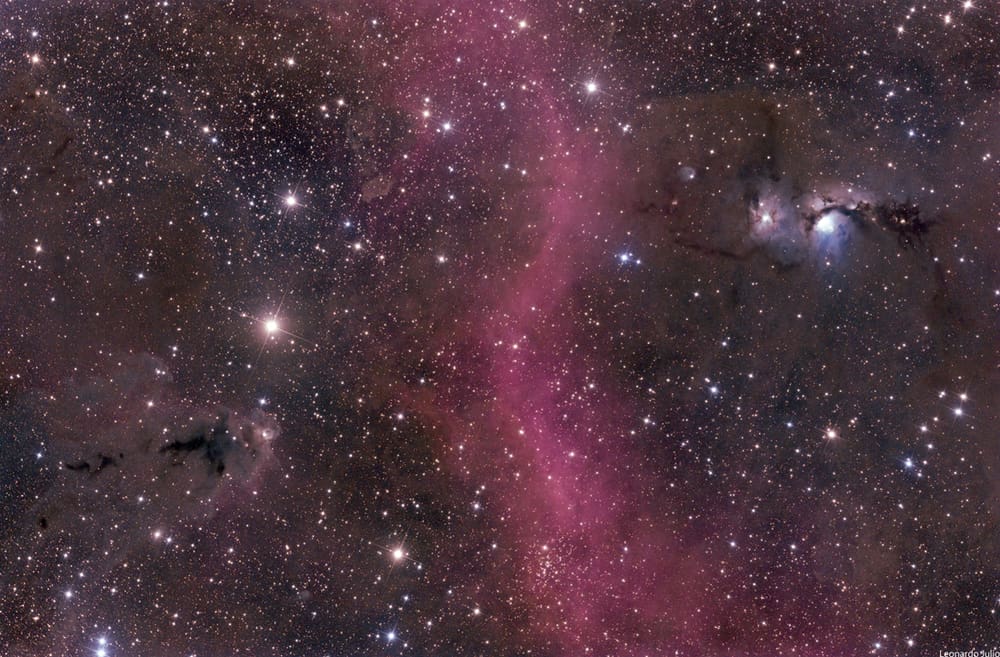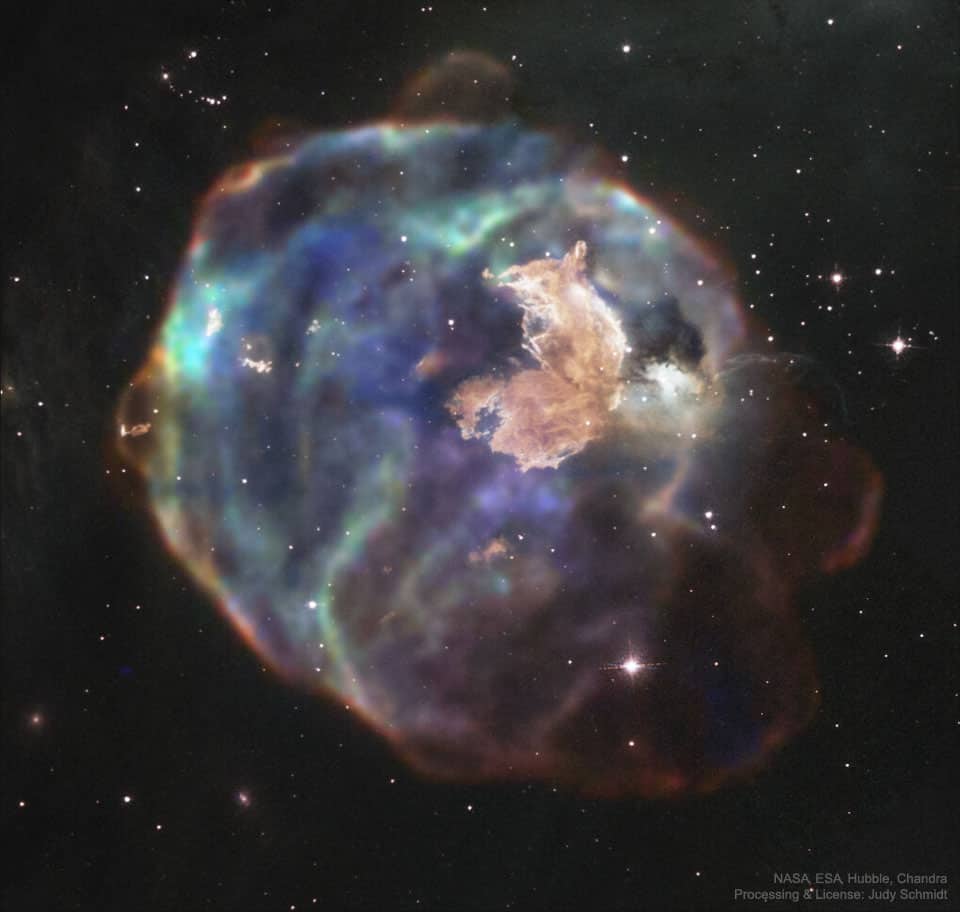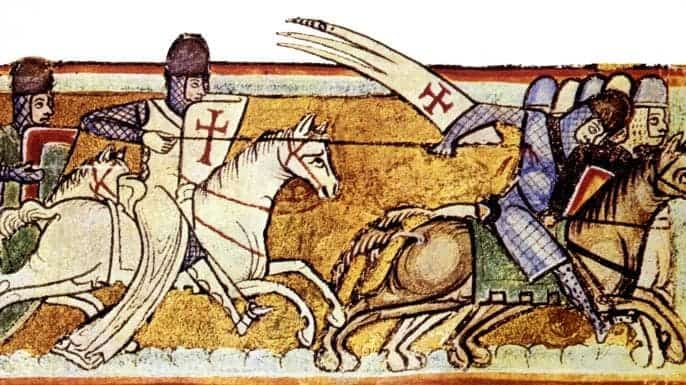Why Friday the 13th Spelled Doom for the Knights Templar
Why are Fridays that fall on a month’s 13th day so fearful?
Some attribute the origins to the Code of Hammurabi, one of the world’s oldest legal documents, which may or may not have superstitiously omitted a 13th rule from its list. Others claim that the ancient Sumerians, who believed the number 12 to be a “perfect” number, considered the one that followed it decidedly non-perfect.
One of the most popular theories, however, links Friday the 13th with the fall of a fearsome group of legendary warriors—the Knights Templar. Founded around 1118 as a monastic military order devoted to the protection of pilgrims traveling to the Holy Land following the Christian capture of Jerusalem during the First Crusade, the Knights Templar quickly became one of the richest and most influential groups of the Middle Ages, thanks to lavish donations from the crowned heads of Europe, eager to curry favor with the fierce Knights. By the turn of the 14th century, the Templars had established a system of castles, churches and banks throughout Western Europe. And it was this astonishing wealth that would lead to their downfall.
For the Templars, that end began in the early morning hours of Friday, October 13, 1307.
A month earlier, secret documents had been sent by couriers throughout France. The papers included lurid details and whispers of black magic and scandalous sexual rituals. They were sent by King Philip IV of France, an avaricious monarch who in the preceding years had launched attacks on the Lombards (a powerful banking group) and France’s Jews (who he had expelled so he could confiscate their property for his depleted coffers).
In the days and weeks that followed that fateful Friday, more than 600 Templars were arrested, including Grand Master Jacques de Molay, and the Order’s treasurer. But while some of the highest-ranking members were caught up in Philip’s net, so too were hundreds of non-warriors; middle-aged men who managed the day-to-day banking and farming activities that kept the organization humming. The men were charged with a wide array of offenses including heresy, devil worship and spitting on the cross, homosexuality, fraud and financial corruption.
For the Templars, that end began in the early morning hours of Friday, October 13, 1307.
A month earlier, secret documents had been sent by couriers throughout France. The papers included lurid details and whispers of black magic and scandalous sexual rituals. They were sent by King Philip IV of France, an avaricious monarch who in the preceding years had launched attacks on the Lombards (a powerful banking group) and France’s Jews (who he had expelled so he could confiscate their property for his depleted coffers).
In the days and weeks that followed that fateful Friday, more than 600 Templars were arrested, including Grand Master Jacques de Molay, and the Order’s treasurer. But while some of the highest-ranking members were caught up in Philip’s net, so too were hundreds of non-warriors; middle-aged men who managed the day-to-day banking and farming activities that kept the organization humming. The men were charged with a wide array of offenses including heresy, devil worship and spitting on the cross, homosexuality, fraud and financial corruption.
The Universe is simply so vast that it can be difficult to maintain a sense of scale. Many galaxies we see through telescopes such as the NASA/ESA Hubble Space Telescope, the source of this beautiful Picture of the Week, look relatively similar: spiralling arms, a glowing centre, and a mixture of bright specks of star formation and dark ripples of cosmic dust weaving throughout.
This galaxy, a spiral galaxy named NGC 772, is no exception. It actually has much in common with our home galaxy, the Milky Way. Each boasts a few satellite galaxies, small galaxies that closely orbit and are gravitationally bound to their parent galaxies. One of NGC 772’s spiral arms has been distorted and disrupted by one of these satellites (NGC 770 — not visible in the image here), leaving it elongated and asymmetrical.
However, the two are also different in a few key ways. For one, NGC 772 is both a peculiar and an unbarred spiral galaxy; respectively, this means that it is somewhat odd in size, shape, or composition, and that it lacks a central feature known as a bar, which we see in many galaxies throughout the cosmos — including the Milky Way. These bars are built of gas and stars, and are thought to funnel and transport material through the galactic core, possibly fueling and igniting various processes such as star formation.

Majida El Roumi Baradhy (Arabic: ماجدة الرومي برادعي; born 13 December 1956) is a Lebanese soprano singer. She is also a UN Goodwill Ambassador. In 1974, she participated in the talent show “Studio El Fan” on Télé Liban and performed songs for Asmahan and Layla Murad at the age of 16.
Majida El Roumi Al Baradhy was born on 14 December 1956 and descends from the Christian “Al Baradhy” family from Tyre, South Lebanon. She is the daughter of the Lebanese musician Halim El Roumi who was born in Tyre in 1919 and moved to Haifa, Palestine at the age of 2 with his whole family due to the crisis of World War I.When Halim moved to Egypt to follow his musical career, he met Marie Loutfy, a Melkite Greek Catholic woman. They got married in Port Said and had three girls Maha, Mona, Majida and a boy Awad. The whole family moved from Egypt to Lebanon and settled in Kfarshima, which is part of Greater Beirut when Majida was at the age of 6 as she grew up in an artistic environment and family of artists. Kfarshima is also home to many Lebanese singers, musicians and poets like Philimon Wehbe, Melhem Barakat and Issam Rajji. The residence of Halim El Roumi was a meeting place for many cultural figures as he worked with many singers with mentioning his discovery to many well-known artists, mainly the Lebanese star Fairuz.
As a child, Majida used to listen to the works of Fairuz, Umm Kulthum, Mohammed Abdel Wahab, Wadih El Safi and Asmahan and at the age of 5 when she sang her first song “Miladak” (Your Birth) in reference to the birth of Jesus Christ and dedicated to her brother on his birthday.
see full post...Benjamin M. Tucker (December 13, 1930 – June 4, 2013) was an American jazz bassist who appeared on hundreds of recordings. Tucker played on albums by Art Pepper, Billy Taylor, Quincy Jones, Grant Green, Dexter Gordon, Hank Crawford, Junior Mance, and Herbie Mann.
He was born in Tennessee. As bass player in the Dave Bailey Quintet in 1961, he wrote the instrumental version of the song “Comin’ Home Baby!“, first issued on the album Two Feet in the Gutter. Bob Dorough later wrote a lyric to the song, and the vocal version became a Top 40 hit for jazz singer Mel Tormé in 1962.
Tucker released the album Baby, You Should Know It (Ava, 1963) with Victor Feldman, Larry Bunker, Bobby Thomas, Ray Crawford, Tommy Tedesco, and Carlos “Patato” Valdes.
By 1972, Tucker owned two radio stations, WSOK-AM, which had over 400,000 listeners, and WLVH-FM. Both of these were located in his hometown of Savannah, Georgia.
He died in a traffic collision in Hutchinson Island, Georgia, on June 4, 2013.
https://www.youtube.com/watch?v=_UBgR3Yj93o
see full post...William Alexander “Sonny” Greer (December 13, c. 1895 – March 23, 1982) was an American jazz drummer and vocalist, best known for his work with Duke Ellington. Greer was born in Long Branch, New Jersey, and played with Elmer Snowden‘s band and the Howard Theatre‘s orchestra in Washington, D.C., before joining Duke Ellington, whom he met in 1919. He was Ellington’s first drummer, playing with his quintet, the Washingtonians, and moving with Ellington into the Cotton Club. As a result of his job as a designer with the Leedy Drum Company of Indiana, Greer was able to build up a huge drum kit worth over a then-considerable $3,000, including chimes, a gong, timpani, and vibes.
Greer was a heavy drinker, as well as a pool-hall hustler (when he needed to retrieve his drums from the pawnbroker), and in 1950 Ellington responded to his drinking and occasional unreliability by taking a second drummer, Butch Ballard, with them on a tour of Scandinavia. This enraged Greer, and the consequent argument led to their permanent estrangement.
Greer continued to play, mainly as a freelance drummer, working with musicians such as Johnny Hodges, Red Allen, J. C. Higginbotham, Tyree Glenn, and Brooks Kerr, as well as appearing in films, and briefly leading his own band. Greer featured in the iconic 1958 black-and-white photograph by Art Kane known as “A Great Day in Harlem“. He was part of a tribute to Ellington in 1974, which achieved great success throughout the United States.
Greer died in 1982 and is interred in Woodlawn Cemetery in The Bronx, New York City.
see full post...Carlos García Montoya (13 December 1903 – 3 March 1993) in Madrid, Spain, was a prominent flamenco guitarist and a founder of the modern-day popular flamenco style of music.
He was the nephew of renowned flamenco guitarist Ramón Montoya. He first learned from his mother, “la Tula”, and then from a neighboring barber, Pepe el Barbero, i.e. Pepe the Barber. After one year Montoya had completed what Pepe was able to teach him. Carlos left to gain what he could from other flamenco guitarists of the time. At fourteen he was playing in the “cafes cantantes,” in the heyday of flamenco singing and dancing, for such artists as Antonio de Bilbao, Juan el Estampío, La Macarrona and La Camisona in Madrid, Spain.
In the 1920s and 1930s he performed extensively in Europe, North America, and Asia with the likes of La Teresina. The outbreak of World War IIbrought him to the United States where he began his most successful days as a musician, bringing his fiery style to concert halls and universities. He also accompanied orchestras. During this period he made a few recordings for several major and independent labels including RCA Victor, Everest and Folkways, performing traditional flamenco music such as Farruca., Malaga and Hokie.
see full post...Bright stars, clouds of dust and glowing nebulae decorate this cosmic scene, a skyscape just north of Orion’s belt. Close to the plane of our Milky Way galaxy, the wide field view spans about 5.5 degrees. Striking bluish M78, a reflection nebula, is on the right. M78’s tint is due to dust preferentially reflecting the blue light of hot, young stars. In colorful contrast, the red sash of glowing hydrogen gas sweeping through the center is part of the region’s faint but extensive emission nebula known as Barnard’s Loop. At lower left, a dark dust cloud forms a prominent silhouette cataloged as LDN 1622. While M78 and the complex Barnard’s Loop are some 1,500 light-years away, LDN 1622 is likely to be much closer, only about 500 light-years distant from our fair planet Earth.

Anthony Tillmon Williams (December 12, 1945 – February 23, 1997) was an American jazz drummer.
Williams first gained fame in the band of trumpeter Miles Davis and was a pioneer of jazz fusion. He was inducted into the Modern Drummer Hall of Fame in 1986. Williams was born in Chicago and grew up in Boston. He was of African, Portuguese, and Chinese descent. He studied with drummer Alan Dawson at an early age, and began playing professionally at the age of 13 with saxophonist Sam Rivers. Saxophonist Jackie McLean hired Williams when he was 16.
At 17 Williams gained attention by joining Miles Davis in what was later dubbed Davis’s Second Great Quintet. Williams was a vital element of the group, called by Davis in his autobiography “the center that the group’s sound revolved around.”[5] His playing helped redefine the role of the jazz rhythm section through the use of polyrhythms and metric modulation. Meanwhile, he recorded his first two albums as leader for Blue Note label, Life Time (1964) and Spring (1965). He also recorded as a sideman for the label including, in 1964, Out to Lunch! with Eric Dolphy and Point of Departurewith Andrew Hill.
In 1969, he formed a trio, the Tony Williams Lifetime, with John McLaughlin on guitar and Larry Young on organ. Lifetime was a pioneering band of the fusion movement. Their first album was Emergency!. After the departures of McLaughlin and bassist Jack Bruce, who had joined the group for its second album, and several more releases, Lifetime disbanded. In 1975, Williams put together a band he called “The New Tony Williams Lifetime”, featuring bassist Tony Newton, pianist Alan Pasqua, and English guitarist Allan Holdsworth, which recorded two albums for Columbia Records, Believe It and Million Dollar Legs.
see full post...Grover Washington Jr. (December 12, 1943 – December 17, 1999) was an American jazz-funk / soul-jazz saxophonist. Along with George Benson, John Klemmer, David Sanborn, Bob James, Chuck Mangione, Dave Grusin, Herb Alpert, and Spyro Gyra, he is considered by many to be one of the founders of the smooth jazz genre. He wrote some of his material and later became an arranger and producer.
Throughout the 1970s and 1980s, Washington made some of the genre’s most memorable hits, including “Mister Magic”, “Reed Seed”, “Black Frost”, “Winelight”, “Inner City Blues” and “The Best is Yet to Come”. In addition, he performed very frequently with other artists, including Bill Withers on “Just the Two of Us” (still in regular rotation on radio today), Patti LaBelle on “The Best Is Yet to Come” and Phyllis Hyman on “A Sacred Kind of Love”. He is also remembered for his take on the Dave Brubeck classic “Take Five“, and for his 1996 version of “Soulful Strut“.
Washington had a preference for black nickel-plated saxophones made by Julius Keilwerth. These included a SX90R alto and SX90R tenor. He also played Selmer Mark VI alto in the early years. His main soprano was a black nickel-plated H. Couf Superba II (also built by Keilwerth for Herbert Couf) and a Keilwerth SX90 in the last years of his life.
Washington was born in Buffalo, New York, United States, on December 12, 1943. His mother was a church chorister, and his father was a collector of old jazz gramophone records and a saxophonist as well, so music was everywhere in the home. He grew up listening to the great jazzmen and big band leaders like Benny Goodman, Fletcher Henderson, and others like them. At the age of 8, Grover Sr. gave Jr. a saxophone. He practiced and would sneak into clubs to see famous Buffalo blues musicians. His younger brother, drummer Daryl Washington, would soon follow in his footsteps.
Washington attended East High School in Buffalo, graduating at age 16.
see full post...Emmanuel N’Djoké Dibango (born 12 December 1933) is a Cameroonian musician and songwriter who plays saxophone and vibraphone. He developed a musical style fusing jazz, funk, and traditional Cameroonian music. His father was a member of the Yabassi ethnic group, though his mother was a Duala. He is best known for his 1972 single “Soul Makossa“.
Dibango was born in Douala, Cameroon. His father, Michel Manfred N’Djoké Dibango, was a civil servant. Son of a farmer, he met his wife travelling by pirogue to her residence, Douala. A literate woman, she was a fashion designer, running her own small business. Both her ethnic group, the Duala, and his, the Yabassi, viewed this union of different ethnic groups with some disdain. Emmanuel had no siblings, although he had a stepbrother from his father’s previous marriage who was four years older than he was. In Cameroon, one’s ethnicity is dictated by one’s father, though Dibango wrote in his autobiography, Three Kilos of Coffee, that he has “never been able to identify completely with either of [his] parents.
He was a member of the seminal Congolese rumba group, African Jazz, and has collaborated with many other musicians, including Fania All Stars, Fela Kuti, Herbie Hancock, Bill Laswell, Bernie Worrell, Ladysmith Black Mambazo, King Sunny Adé, Don Cherry, and Sly and Robbie. He achieved a considerable following in the UK with a disco hit called “Big Blow”, originally released in 1976 and re-mixed as a 12″ single in 1978 on Island Records. In 1998, he recorded the album CubAfrica with Cuban artist Eliades Ochoa. GRAMMY nominated artist.
The song “Soul Makossa” on the record of the same name contains the lyrics “makossa”, which means “(I) dance” in his native tongue, the Cameroonian language Duala. It has influenced several popular music hits, including Michael Jackson‘s “Wanna Be Startin’ Somethin’“, as well as his re-recording of that song with Akon, the Fugees‘ “Cowboys”, and Rihanna‘s “Don’t Stop the Music“.[citation needed] The 1982 parody song “Boogie in your butt” by comedian Eddie Murphy interpolates Soul Makossa’s bassline and horn charts while “Butt Naked Booty Bless” by 1990s hip-hop group Poor Righteous Teachers heavily samples its musical bridge and drum patterns.
see full post...Toshiko Akiyoshi (秋吉 敏子 or 穐吉 敏子 Akiyoshi Toshiko, born 12 December 1929) is a Japanese jazz pianist, composer, arranger, and bandleader.
She has received fourteen Grammy Award nominations and was the first woman to win Best Arranger and Composer awards in Down Beatmagazine’s annual Readers’ Poll. In 1984, she was the subject of the documentary Jazz Is My Native Language. In 1996, she published her autobiography, Life with Jazz, and in 2007 she was named an NEA Jazz Master by the U.S. National Endowment for the Arts.
Akiyoshi was born in Liaoyang, Manchuria to Japanese emigrants. She was the youngest of four sisters. In 1945, after World War II, Akiyoshi’s family lost their home and returned to Japan, settling in Beppu. A local record collector introduced her to jazz by playing a record of Teddy Wilsonplaying “Sweet Lorraine“. She immediately loved the sound and began to study jazz. In 1952, during a tour of Japan, pianist Oscar Petersondiscovered her playing in a club on the Ginza. Peterson was impressed and convinced record producer Norman Granz to record her. In 1953, under Granz’s direction, she recorded her first album with Peterson’s rhythm section: Herb Ellis on guitar, Ray Brown on double bass, and J. C. Heard on drums. The album was released with the title Toshiko’s Piano in the U.S. and Amazing Toshiko Akiyoshi in Japan.
https://www.youtube.com/watch?v=4mosYwYB-8E
see full post...
https://www.youtube.com/watch?v=fIMJEKUR9Xc
see full post...What has this supernova left behind? As little as 2,000 years ago, light from a massive stellar explosion in the Large Magellanic Cloud (LMC) first reached planet Earth. The LMC is a close galactic neighbor of our Milky Way Galaxy and the rampaging explosion front is now seen moving out – destroying or displacing ambient gas clouds while leaving behind relatively dense knots of gas and dust. What remains is one of the largest supernova remnants in the LMC: N63A. Many of the surviving dense knots have been themselves compressed and may further contract to form new stars. Some of the resulting stars may then explode in a supernova, continuing the cycle. Featured here is a combined image of N63A in the X-ray from the Chandra Space Telescope and in visible light by Hubble. The prominent knot of gas and dust on the upper right — informally dubbed the Firefox — is very bright in visible light, while the larger supernova remnant shines most brightly in X-rays. N63A spans over 25 light years and lies about 150,000 light years away toward the southern constellation of Dorado.

Alfred McCoy Tyner (born December 11, 1938) is a jazz pianist from Philadelphia known for his work with the John Coltrane Quartet and a long solo career. Tyner was born in Philadelphia as the oldest of three children. He was encouraged to study piano by his mother. He began studying the piano at age 13 and within two years music had become the focal point in his life. When he was 17, he converted to Islam through the Ahmadiyya Muslim Community and changed his name to Sulieman Saud. His neighbors in Philadelphia included musicians Richie Powell and Bud Powell. Tyner started his career in 1960 as a member of the Jazztet led by Benny Golson and Art Farmer. Six months later, he joined the quartet of John Coltrane that included Jimmy Garrison and Elvin Jones. He worked with the band during its extended run at the Jazz Gallery, replacing Steve Kuhn(Coltrane had known Tyner for a while in Philadelphia, and performed one of the pianist’s compositions, “The Believer”, as early as 1958). He played on Coltrane’s “My Favorite Things” for Atlantic. The band toured almost non-stop between 1961 and 1965, recording the albums Live! at the Village Vanguard, Ballads, Live at Birdland, Crescent, A Love Supreme, and The John Coltrane Quartet Plays for Impulse!.
While in Coltrane’s group, he recorded albums as a leader in a piano trio. He also appeared as a sideman on many Blue Note albums of the 1960s, although he was often credited as “etc.” on the cover of these albums to respect his contract with Impulse! Records.
see full post...Willie Mae Thornton (December 11, 1926 – July 25, 1984), better known as Big Mama Thornton, was an American rhythm-and-blues singer and songwriter. She was the first to record Leiber and Stoller’s “Hound Dog“, in 1952, which became her biggest hit, staying seven weeks at number one on the Billboard R&B chart in 1953 and selling almost two million copies. Thornton’s other recordings included the original version of “Ball and Chain“, which she wrote.
Thornton’s birth certificate states that she was born in Ariton, Alabama, but in an interview with Chris Strachwitz she claimed Montgomery, Alabama, as her birthplace, probably because Montgomery was better known than Ariton. She was introduced to music in a Baptist church, where her father was a minister and her mother a singer. She and her six siblings began to sing at early ages. Her mother died young, and Willie Mae left school and got a job washing and cleaning spittoons in a local tavern. In 1940 she left home and, with the help of Diamond Teeth Mary, joined Sammy Green’s Hot Harlem Revue and was soon billed as the “New Bessie Smith“. Her musical education started in the church but continued through her observation of the rhythm-and-blues singers Bessie Smith and Memphis Minnie, whom she deeply admired.
see full post...Dámaso Pérez Prado (Spanish: [ˈpeɾes ˈpɾaðo]; December 11, 1916 – September 14, 1989) was a Cuban bandleader, pianist and composer who popularized the mambo in the late 1940s. He frequently made brief appearances in films, primarily of the rumberas genre. The success of his orchestra and hits such as “Mambo No. 5” earned him the nickname “King of the Mambo”. His stage name was simply Pérez Prado, although his brother Pantaleón also used the same name in the 1970s, which led to confusion. Pérez Prado became a naturalized citizen of Mexico in 1980, where he died in 1989. His son, Pérez Jr., continues to direct the Pérez Prado Orchestra in Mexico City to this day.
Pérez was born in Matanzas, Cuba, on December 11, 1916; his mother Sara Prado was a school teacher, his father Pablo Pérez a journalist at El Heraldo de Cuba. He studied classical piano in his early childhood, and later played organ and piano in local clubs. For a time, he was pianist and arranger for the Sonora Matancera, Cuba’s best-known musical group at the time. He also worked with casino orchestras in Havana for most of the 1940s. He was nicknamed “El Cara de Foca” (“Seal Face”) by his peers at the time.
see full post...

